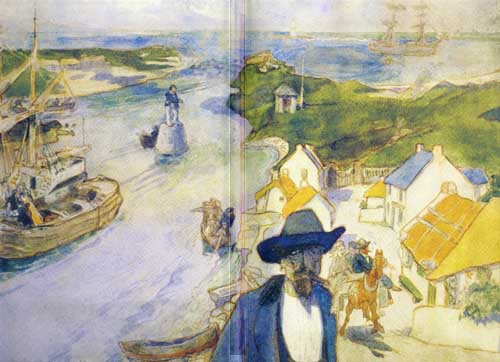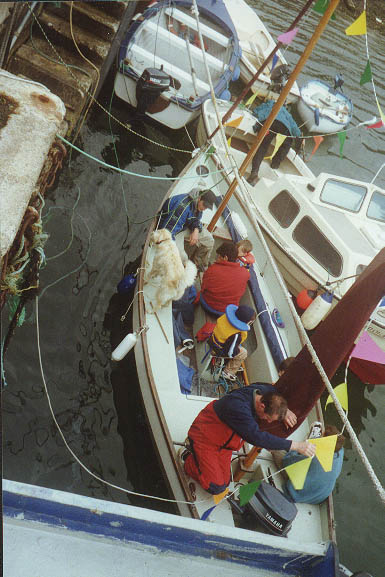
Memory Harbour
By John C. McTernan

Memory Harbour is the title of an early painting by Jack B Yeats, showing houses, an anchored ship, the Metal Man and a bearded pilot. His brother, William Butler Yeats, the poet, commented as follows on the scene thus depicted:
"Memory Harbour is the village of Rosses Point but with distances shortened and the houses run together as in an old-fashioned panoramic map. The man on the pedestal in the middle of the river is The Metal Man, and he points to where the water is deep enough for ships. The coffin, cross-bones and skull, and boat at the point of the head-land, are to remind one of the sailor who was buried there by a ship’s crew in a hurry not to miss the tide. As they were not sure if he was really dead they buried him with a loaf, as the story runs".
W.B. returned to the same theme more than once in "Autobiographies":
"When I look at my brother’s picture, Memory Harbour.. houses and anchored ship and distant light-house all set close together as in some old map.. I recognize in the blue-coated man with the mass of white shirt the pilot I went fishing with, and I am full of disquiet and of excitement, and I am melancholy because I have not made more and better verses. I have walked on Sinbad’s yellow shore and never shall an-other’s hit my fancy".
Elsewhere, he writes: "In half the pictures he paints I recognise faces that I have met at Rosses Point or the Sligo Quays".
Jack Yeats spent much of his boyhood at Rosses Point. It was the peninsula there that he depicted as his harbour of memories, with the smoke of the Elsinore, the summer house of his cousins, the Middletons, rising from behind the hillock. The watercolour Memory Harbour contains many of the images he was to develop in later works, such as Sailor Home from the Sea, Sligo Bay, The Grain Ship, The Pilot, The Old Pilot House, Deadman’s Point, The Metal Man, The SS Liverpool and The Sea Captain’s Car.. the front seat of which was always reserved for his uncle, George T. Pollexfen. The peaked capped Pilot was to become a regular theme in his paintings; as was William Gillen and Captain Keebles, the Harbour Master.. the latter stern, in bowler hat, with fashionable beard and umbrella. The maritime influence, especially that of Rosses Point, permeates most of the artist’s work.
 Yeats,
the painter, succeeded in bringing to life the old days at the Point, at the mouth of
Sligo Harbour. He immortalised a mood and perhaps a youthful memory. The bearded sailor
may no longer be there and the line of white-washed cottages have expanded into something
more than a hamlet, but the lapse of a century or so has made little or no difference in
the essentials of the scene or, for that matter, on the spirit of the place. There are
still the cottages, although in some cases the gardens have been shortened or have
completely disappeared, and there still stands the Metal Man, hand outstretched, directing
the handful of vessels that enter the Port annually. Happily, the maritime tradition also
lives on and the Point continues to be a mecca for seafarers from near and far.
Yeats,
the painter, succeeded in bringing to life the old days at the Point, at the mouth of
Sligo Harbour. He immortalised a mood and perhaps a youthful memory. The bearded sailor
may no longer be there and the line of white-washed cottages have expanded into something
more than a hamlet, but the lapse of a century or so has made little or no difference in
the essentials of the scene or, for that matter, on the spirit of the place. There are
still the cottages, although in some cases the gardens have been shortened or have
completely disappeared, and there still stands the Metal Man, hand outstretched, directing
the handful of vessels that enter the Port annually. Happily, the maritime tradition also
lives on and the Point continues to be a mecca for seafarers from near and far.
Many of the Yeatsian associations with the Port have been highlighted in the writing of W.B.Yeats. His grandfather, William Pollexfen, was one of the principal shareholders in the Sligo Steam Navigation Company which acted as agents for the Liverpool steamers, the SS Sligo and the SS Liverpool. As a young boy on his way from London to visit his maternal grandparents in Sligo he travelled on the steamers. In Autobiographies he recalls his close affinity with the vessels and their crew:
"When I arrived at the Clarence Basin, Liverpool, on my way to Sligo for my holidays I was among Sligo people. When I was a little boy, an old woman who had come to Liverpool with crates of food made me miserable by throwing her arms around me, the moment I had alighted from the cab, and telling the sailor who carried my luggage that she had held me in her arms when I was a baby. The sailor may have known me almost as well, for I was often at Sligo quay to sail my boat; and I came and went once or twice in every year upon the SS Sligo or the SS Liverpool which belonged to a company that had for directors my grandfather and his partner William Middleton. I was always pleased if it was the Liverpool, for she had been built to run the blockade during the war of North and South".
During the holidays he would visit his Middleton cousins at Elsinore, overlooking Memory Harbour, where he fished for skate and herring and then returned to Sligo on one of Middleton’s channel steamers, where he overheard many tales that subsequently provided material for his writings:
"Indeed so many stories did I hear from sailors along the wharf, or round the forcastle fire of that little steamer that ran between Sligo and Rosses, or from boys out fishing, that the world seemed full of monsters and marvels".
In The Old Men of the Twilight he described the former Pilot House at Rosses Point:
"At the place, close to the Deadman’s Point at the Rosses, where the disused pilot house looks out to sea through two round windows like eyes, a mud cottage stood in the last century. It also was a Watch House for a certain old Michael Bruen, who had been a smuggler, and was still the father and grandfather of smugglers, lived there, and when after night-fall, a tall French schooner crept over the bay from Raughley, it was his business to hang a horn lantern in the southern window, that news might travel to Dorren’s Island, and thence by another horn lantern, to the village of the Rosses".
Another youthful memory prompted the rather picturesque title On the Boiler, a compilation in prose and verse inspired by a mad ship’s carpenter called McCoy, of whom his Pollexfen grandparents used to speak:
"When I was a child and wandering about the Sligo Quays I saw a printed, or was it a painted notice? On such and such a day ‘the great McCoy will speak on the old boiler’. I knew the old boiler ,very big, very high, the top far out of reach, and all red rust. I wanted to go and hear him for the boiler’s sake, but nobody encouraged me. I was told then or later that he was a mad ship’s carpenter, very good at his trade if he would stick to it, but he went to bed from autumn to spring and during his working months broke off from time to time to read the Scriptures and denounce his neighbours".
On the death of his uncle, George T. Pollexfen, W.B. Yeats inherited shares in the Sligo Steam Navigation Company, but he disposed of them in 1917 and forwarded the money to his impoverished father, John B. Yeats, then residing in New York.
The passage of time has wrought many changes in and around Memory Harbour. Most of the old associations and personalities have gone forever. The Yeatses and their relations have all passed on. The Sligo Steam Navigation Company and the Liverpool steamers.. for so long an integral part of the scene.. have also disappeared. Sligo Quays, once a hive of activity and the embarkation point of countless thousands of emigrants, are deserted and silent. The glory days of the Port.. of Yeats’ Memory Harbour.. are gone forever.